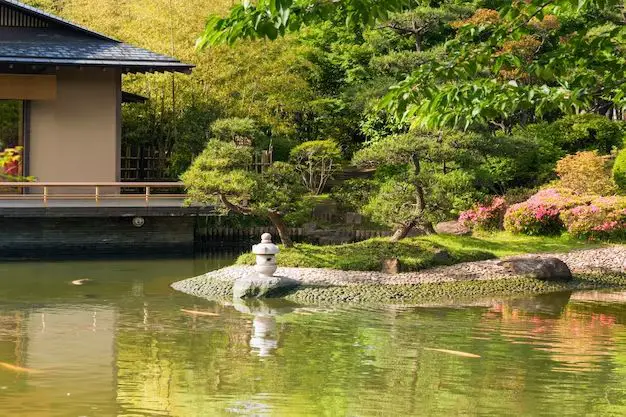There are some differing opinions on whether Zen gardens can include water features. Here are some quick answers to key questions about water in Zen gardens:
Page Contents
- 1 What is a Zen garden?
- 2 Do traditional Zen gardens have water features?
- 3 Can modern Zen gardens include water?
- 4 What are some pros of including water features?
- 5 What are some cons of adding water elements?
- 6 Examples of Zen gardens with water features
- 7 How to incorporate water mindfully
- 8 Conclusion
- 9 References
What is a Zen garden?
A Zen garden is a style ofJapanese garden that creates a miniature stylized landscape through carefully composed arrangements of rocks, pruned plants, and pathways set on a bed of sand or gravel. The purpose of a Zen garden is to facilitate meditation and promote spiritual reflection.
Do traditional Zen gardens have water features?
The traditional karesansui or “dry landscape” style Zen garden does not contain water features. The lack of water allows the garden to represent water or the sea through the careful placement and patterns of rocks and gravel. The empty space and abstraction encourages contemplation.
Can modern Zen gardens include water?
While traditional Zen gardens follow strict rules excluding water, modern Zen gardens sometimes incorporate water features. This includes ponds, streams, waterfalls and fountains. The sound and movement of water can aid relaxation and reflection. However, the water features are kept simple and understated.
What are some pros of including water features?
- Provides soothing auditory stimulation
- Adds dynamic movement to the garden
- Allows inclusion of fish or water plants
- Creates opportunities for reflection on the natural flow, changes and cycles of water
- Adds humidity to the garden environment
Auditory benefits
The tranquil sound of flowing or falling water redirects awareness and promotes mental quietude. Listening mindfully to water can induce a meditative state.
Visual benefits
The reflective qualities of water create opportunities to contemplate impermanence and the constant flux of reality. Ripples across a pond echo life’s inherent fluidity.
What are some cons of adding water elements?
- More maintenance required
- Increased installation expenses
- Potential safety hazards
- Can conflict with traditional karesansui principles
- May detract from meditative emptiness of dry gardens
Practical considerations
Including water features increases upkeep requirements, including cleaning, pumping, filtration and replenishment. Water features also raise installation costs.
Philosophical implications
Many Zen purists argue water goes against the meditative nothingness and detached austerity of an authentic dry Zen garden space. The minimalism encourages inward focus.
Examples of Zen gardens with water features
Here are some examples of Zen gardens that incorporate water elements:
Portland Japanese Garden (Oregon)
This large Zen-inspired garden includes a scenic pond, stream and multiple waterfalls. Visitors cross the ponds via stone bridges. The water provides tranquility and contrast to the serene moss and boulder compositions.
Anderson Japanese Garden (Rockford, IL)
Waterfalls, streams and ponds containing vivid koi fish populate this public park modeled on Japanese aesthetic principles. The winding waterways invite peaceful contemplation.
Koto-in Temple (Daimonji, Japan)
This small Zen temple garden centres around a rectangular pond containingcarp. The fish hold symbolic meaning in Zen philosophy. Stone lanterns dot the pond’s edge.
Daisen-in Temple (Kyoto, Japan)
This historic Zen rock garden contains a miniature pond and stream representing the flow of life. The water provides soothing auditory effects and visual dynamism.
Kyu Shiba Rikyu Garden (Tokyo, Japan)
Traditional water basins and fountains accentuate this 20th century gardens landscape of gravel and rock groupings. The historic fountains support meditation.
How to incorporate water mindfully
Here are some tips for integrating water features successfully into a Zen garden:
- Use water sparingly to avoid clutter or distraction
- Select peaceful, gentle water forms like small ponds or trickling streams
- Focus on serene auditory qualities, not elaborate designs
- Include elements like stone basins or bamboo spouts to control flow
- Locate water where it can reflect sky or surrounding plants
- Allow water to highlight garden contours through winding streams
Conclusion
While traditional karesansui Zen gardens exclude water, modern interpretations sometimes incorporate modest water features. The sound, movement and reflective qualities of water can enhance the meditative ambiance if used judiciously. Water offers a way to represent natural cycles and change. However, too much emphasis on water decoration can undermine the empty, austere spirit of a Zen garden space. Careful, minimalist inclusion of water can complement the spiritual purposes of mindful gardens.
References
Books
- Zen Gardens and Temples of Kyoto: A Guide to Their History, Meaning, and Design
- The Art of Setting Stones: And Other Writings from the Japanese Garden
- The Japanese Garden: Gateway to the Human Spirit
